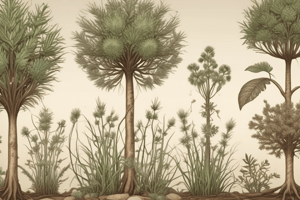Podcast
Questions and Answers
What is the significance of endosperm formation during double fertilization in angiosperms?
What is the significance of endosperm formation during double fertilization in angiosperms?
- It helps in attracting pollinators for successful pollination
- It aids in the dispersal of pollen grains
- It assists in the formation of the zygote
- It plays a crucial role in providing nutrition to the developing embryo (correct)
In angiosperms, where does the pollen tube unite with the egg cell during double fertilization?
In angiosperms, where does the pollen tube unite with the egg cell during double fertilization?
- Within the pollen grain
- Inside the ovule (correct)
- On the stigma
- Along the style
What is the main method of pollination in angiosperms like sunflowers?
What is the main method of pollination in angiosperms like sunflowers?
- Wind (correct)
- Animals
- Gravity
- Water
After contact with the egg cell in an archegonium, what is formed?
After contact with the egg cell in an archegonium, what is formed?
What happens to the pollen tube after it lands on an angiosperm's stigma?
What happens to the pollen tube after it lands on an angiosperm's stigma?
What is the main difference between gymnosperms and angiosperms?
What is the main difference between gymnosperms and angiosperms?
In seed plants, where are female gametes produced?
In seed plants, where are female gametes produced?
Where are the male gametes (pollen) produced in seed plants?
Where are the male gametes (pollen) produced in seed plants?
How do gymnosperms and angiosperms differ in their pollination methods?
How do gymnosperms and angiosperms differ in their pollination methods?
What structures contain female gametes in gymnosperms?
What structures contain female gametes in gymnosperms?
Study Notes
Spermatophytes: Understanding Gymnosperms, Angiosperms, and Their Reproductive Systems
Introduction
Spermatophytes are a group of plants commonly referred to as seed plants. They comprise two major subgroups: gymnosperms and angiosperms. While both types share reproductive strategies, they possess distinct characteristics. Let's explore the differences between the two subgroups and delve deeper into their reproductive systems.
Gymnosperms vs. Angiosperms
Gymnosperms are non-flowering plants characterized by naked seeds, which are not enclosed in an ovary. Examples of gymnosperms include conifers like pine trees, cypress, and redwoods. On the other hand, Angiosperms, also known as flowering plants, contain seeds encased in an ovary derived from the inner whorl of the perianth. Some common examples of angiosperms are oak trees, sunflowers, and roses.
Reproductive System in Seed Plants
In both gymnosperms and angiosperms, male gametes (pollen) and female gametes (spores) are produced within specialized structures called strobiles. The female strobilus forms cones, which contain archegonia, where female gametes are produced. The male strobilus produces pollen, which is dispersed via wind or insects.
Pollination and Fertilization in Gymnosperms
Gymnosperm pollen is wind-pollinated, meaning the pollen grains are carried by air currents to reach the archegonia on different plants. Once the pollen grain reaches an archegonium, it germinates into a pollen tube that grows through the funnel-like structure of the archegonial canal towards the egg cell. After contact with the egg cell, fertilization occurs, leading to the formation of a zygote.
Pollination and Fertilization in Angiosperms
Angiosperm pollination can occur via multiple methods, including wind, water, animals, and even gravity. For example, angiosperms like sunflowers rely on wind for pollination, while orchids use insects as pollinators. Once a pollen grain lands on an angiosperm's stigma, the pollen tube will grow down the style and enter the ovule. Inside the ovule, the pollen tube unites with the egg cell, resulting in double fertilization. Double fertilization involves two separate events: the fusion of the male nucleus (sperm) and the female nucleus (egg), subsequently forming a zygote. Additionally, another event known as endosperm formation also takes place during this process, which plays a crucial role in providing nutrition to the developing embryo.
Conclusion
Understanding the differences between gymnosperms and angiosperms, as well as their respective reproductive systems, sheds light on the diverse adaptations and strategies employed by seed plants for reproduction. Both subgroups showcase unique ways in which pollen and spores are produced, dispersed, and fertilize eggs to produce seeds that sustain the life cycle of these fascinating organisms.
Studying That Suits You
Use AI to generate personalized quizzes and flashcards to suit your learning preferences.
Description
Explore the differences between gymnosperms and angiosperms, their reproductive systems, and the process of pollination and fertilization in seed plants. Learn about the unique characteristics of naked seeds in gymnosperms and seeds encased in an ovary in angiosperms, as well as the specialized structures involved in producing male and female gametes.




